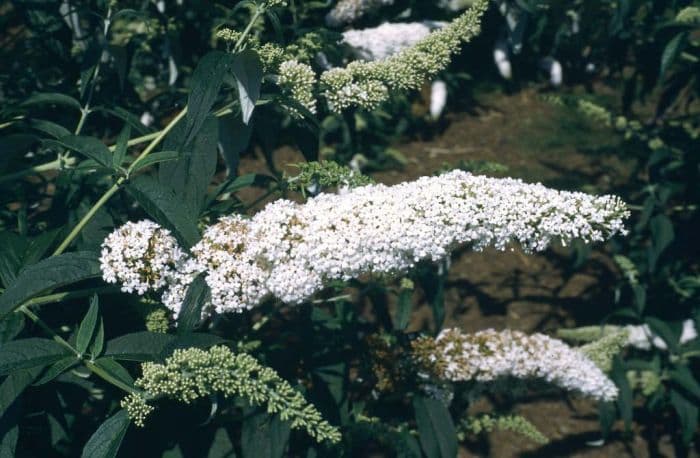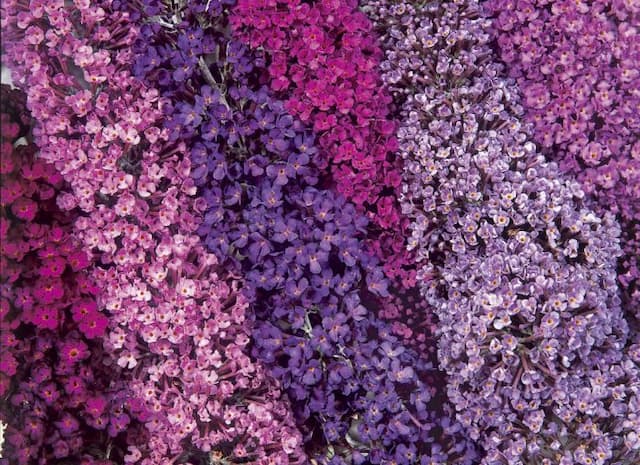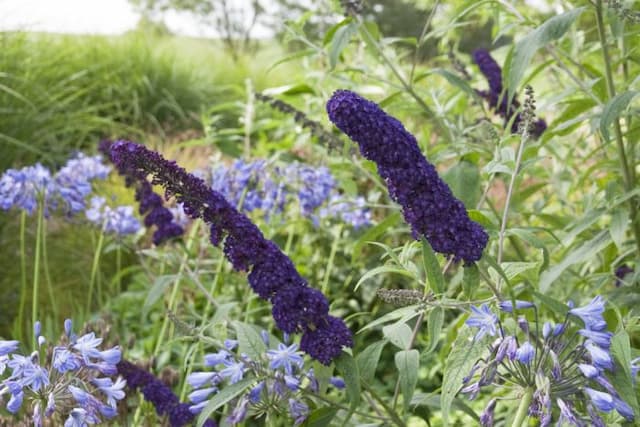Butterfly Bush Buddleja davidii 'White Profusion'

ABOUT
The Butterfly Bush 'White Profusion' is an eye-catching shrub characterized by its long, arching branches and lush foliage. The leaves are lance-shaped, with a pointed tip and a textured surface, sporting a deep green color that serves as a backdrop for the true stars of the show—the flowers. Throughout the blooming season, this plant becomes adorned with numerous conical clusters of tiny, tubular blooms, each individual flower pure white in color and sweetly fragrant. These attractive blooms form at the ends of the branches and create an impressive display that can catch anyone's attention. The overall aspect of the Butterfly Bush 'White Profusion' is one of abundance and vibrancy, making it a popular choice for gardeners looking to add a touch of elegance to their landscape. Its ability to attract butterflies and other pollinators adds a dynamic layer of activity and interest to the garden environment.
About this plant
 Names
NamesFamily
Scrophulariaceae.
Synonyms
Butterfly Bush, Summer Lilac, Orange Eye.
Common names
Buddleja davidii 'White Profusion'.
 Toxicity
ToxicityTo humans
Buddleja, commonly known as butterfly bush, is not considered highly toxic to humans. There is limited information on its toxicity, but it is generally not regarded as a poisonous plant. Ingesting parts of the butterfly bush may potentially cause mild gastrointestinal discomfort due to the saponins it contains, which can have a mild toxic effect if consumed in large quantities. However, poisoning from this plant is rare, and significant health consequences from ingesting butterfly bush are not commonly reported.
To pets
Butterfly bush is similarly not considered highly toxic to pets. While the ingestion of butterfly bush, especially in large quantities, might cause mild gastrointestinal upset in some animals due to the presence of saponins, it is not known to be severely toxic. Symptoms could include vomiting or diarrhea, but serious poisoning is not typically reported. However, it is always advisable to prevent pets from eating plants, as individual animals may have different sensitivities or reactions.
 Characteristics
CharacteristicsLife cycle
Perennials
Foliage type
Deciduous
Color of leaves
Green
Flower color
White
Height
6-10 feet (1.8-3 m)
Spread
4-15 feet (1.2-4.5 m)
Plant type
Shrub
Hardiness zones
5-9
Native area
China
Benefits
 General Benefits
General Benefits- Attracts pollinators: The flowers of the butterfly bush are known to attract butterflies, bees, and other beneficial pollinators to the garden.
- Easy to grow: This plant is hardy and easy to care for, requiring minimal maintenance once established.
- Long blooming period: The butterfly bush produces flowers from mid-summer to early fall, providing extended color and interest in the garden.
- Drought resistant: Once established, it can tolerate periods of low water, making it suitable for xeriscaping and water-wise gardens.
- Fast-growing: This shrub quickly reaches its mature size, making it a good choice for gardeners looking to fill space rapidly.
- Deer resistant: The butterfly bush is not a preferred food source for deer, which can help protect it from browsing in areas with large deer populations.
- Ornamental qualities: With its arching branches and clusters of white flowers, the butterfly bush adds visual interest to the landscape.
- Variety of uses: It can be used in a range of garden designs, including borders, hedges, and as a focal point.
- Cut flowers: The blooms make for beautiful cut flowers, allowing you to bring a piece of your garden indoors.
 Medical Properties
Medical PropertiesThis plant is not used for medical purposes.
 Air-purifying Qualities
Air-purifying QualitiesThis plant is not specifically known for air purifying qualities.
 Other Uses
Other Uses- Butterfly attraction in educational settings: The Butterfly Bush can be planted in school gardens or nature centers to educate students on pollination and the life cycle of butterflies.
- Privacy screening in gardens: Owing to its rapid growth and bushy habit, it can be used to create a natural screen for privacy in residential areas.
- Erosion control: Its root system can help stabilize slopes and prevent soil erosion in prone areas.
- Habitat restoration: The Butterfly Bush is sometimes included in projects aiming to restore native butterfly habitats or create new ones.
- Photography and art subjects: Its aesthetically pleasing flowers make it a popular choice for photographers and artists looking for natural subjects.
- Theme gardens: The Butterfly Bush fits well into themed garden designs, such as white gardens or night gardens, where its flowers stand out in the dusk.
- Culinary decoration: Although not edible, the flowers can be used as a temporary ornamental garnish for plating in high-end culinary presentations.
- Windbreaks for smaller plants: Dense plantings of the Butterfly Bush can provide protection from wind for more delicate garden species.
- Crafting: Dried branches of the Butterfly Bush can be used in crafting, such as making wreaths or other dried flower arrangements.
- Beekeeping support: Planting Butterfly Bush near beehives can support honey production by providing an additional nectar source for bees.
Interesting Facts
 Feng Shui
Feng ShuiThe Butterfly Bush is not used in Feng Shui practice.
 Zodiac Sign Compitability
Zodiac Sign CompitabilityThe Butterfly Bush is not used in astrology practice.
 Plant Symbolism
Plant Symbolism- Transformation: Buddleja plants, commonly known as Butterfly Bush, often symbolize change and transformation because they attract butterflies, which are deep symbols of life changes and metamorphosis.
- New Beginnings: The Butterfly Bush is also linked to new beginnings as it is a magnet for butterflies that represent rebirth and fresh starts.
- Hope: With its lush blooms and capacity to attract life, it brings a sense of hope, reflecting the plant's ability to regenerate and attract new growth.
- Attraction: As its common name suggests, the Butterfly Bush draws in butterflies, symbolizing its ability to attract beauty and positivity to someone's garden and life.
- Inspirational: The sight of butterflies flitting about the Butterfly Bush can inspire creativity and joy, suggesting the plant's connection to inspiration and the muse.
 Water
WaterThe Butterfly Bush requires regular watering, particularly during its first growing season to establish a deep, extensive root system. Once established, the Butterfly Bush is relatively drought-tolerant and needs less frequent watering. In general, it's best to water deeply every week, providing about one to two gallons of water depending on weather conditions. Always check the soil moisture before watering—if the top inch of soil is dry, it's time to water the plant. Avoid overwatering, as this can lead to root rot.
 Light
LightThe Butterfly Bush thrives in full sun, needing at least six to eight hours of direct sunlight each day. It performs best when planted in a spot where it can receive unfiltered sunlight throughout the day. If placed in too much shade, the Butterfly Bush may produce fewer flowers and have a less vigorous growth.
 Temperature
TemperatureButterfly Bushes are hardy and can withstand a range of temperatures, generally thriving in conditions between 60 and 90 degrees Fahrenheit. They can survive in temperatures as low as 20 degrees Fahrenheit and as high as 100 degrees Fahrenheit, but it's important to avoid extreme heat or cold exposure for extended periods. The ideal conditions for the Butterfly Bush would be a temperate climate where extreme temperature fluctuations are rare.
 Pruning
PruningPruning the Butterfly Bush is important for maintaining its shape and encouraging more prolific blooming. Prune in late winter or early spring before new growth emerges. Cut back the previous year's growth to leave only about 10 to 12 inches of stems above the ground. This promotes healthy new shoots and abundant flowers. It's also advisable to deadhead spent flowers to encourage additional blooming.
 Cleaning
CleaningAs needed
 Soil
SoilThe Butterfly Bush prefers well-drained soil composed of loam, chalk, or sand which can be enriched with organic matter to retain some moisture. A soil pH that is slightly acidic to neutral, ranging from 6.0 to 7.0, is optimal for 'White Profusion'.
 Repotting
RepottingButterfly Bush typically doesn't require frequent repotting. It should be repotted when it becomes root-bound or outgrows its current container, which for young plants might be every couple of years, and less often as they mature.
 Humidity & Misting
Humidity & MistingButterfly Bush 'White Profusion' is tolerant of a wide range of humidity conditions and does not require high humidity, thriving in the humidity levels commonly found in temperate climates.
 Suitable locations
Suitable locationsIndoor
Butterfly Bush indoors: ensure full sun, prune for size, and maintain airflow.
Outdoor
Plant in sun, well-draining soil, prune yearly, hardy growth.
Hardiness zone
5-9 USDA
 Life cycle
Life cycleBuddleja davidii 'White Profusion', commonly known as Butterfly Bush, begins life as a seed that germinates in warm, well-drained soil under full sun or partial shade. Seedlings emerge and establish a root system before developing shoots and leaves. As the plant matures, it becomes a woody, deciduous shrub with elongated branches that bear dense clusters of fragrant white flowers throughout the summer, attracting pollinators like butterflies and bees. After blooming, the flowers give way to small capsules containing seeds that, once mature, are dispersed by the wind, allowing for self-sowing or manual collection for propagation. In the fall, the leaves turn yellow and drop off as the plant enters dormancy over the winter months. The shrub rejuvenates in spring, resuming growth from the previous year's woody stems and completing its perennial cycle.
 Propogation
PropogationPropogation time
Spring-Early Summer
The Butterfly Bush, specifically the Buddleja davidii 'White Profusion', can be propagated most effectively through semi-hardwood cuttings. This process begins in late summer after flowering has ended, when the new growth has started to mature and harden slightly. To propagate, select a healthy stem and cut a 4 to 6-inch (10 to 15 cm) length, making sure there are several nodes present. Strip the leaves from the lower half of the cutting and dip the cut end into rooting hormone powder to encourage root development. The prepared cutting should then be placed into a pot filled with a mix of peat and perlite, ensuring good drainage. Covering the pot with a plastic bag helps to retain humidity, which is crucial during the rooting process. Keep the cutting in a warm location out of direct sunlight until it has rooted, which typically takes a few weeks.


![Butterfly bush [Adonis Blue]](/_next/image?url=https%3A%2F%2Fplants-admin.emdemapps.com%2Fimages%2Fplants%2F%2Fimages%2F604b56e58f983.png&w=640&q=75)


![Butterfly bush [Buzz Ivory]](/_next/image?url=https%3A%2F%2Fplants-admin.emdemapps.com%2Fimages%2Fplants%2F%2Fimages%2F604b57987dfa8.png&w=640&q=75)
![Butterfly bush [Camberwell Beauty]](/_next/image?url=https%3A%2F%2Fplants-admin.emdemapps.com%2Fimages%2Fplants%2F%2Fimages%2F604b5ead04c12.png&w=640&q=75)


